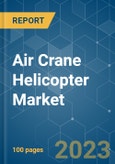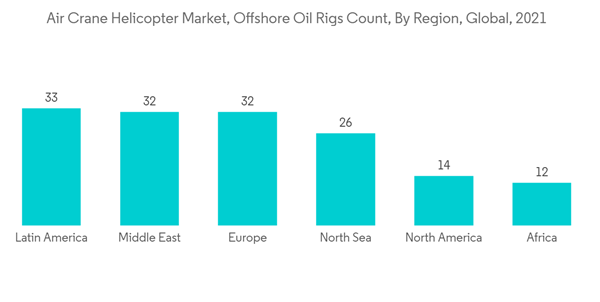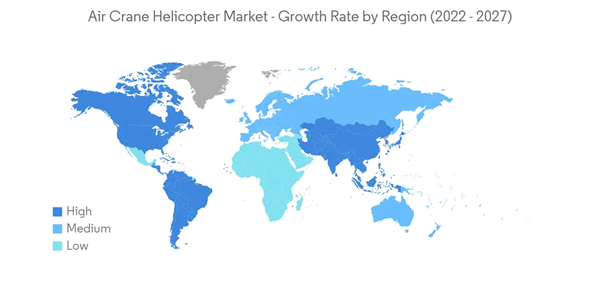This was evident in the last two years when the world witnessed the impact of the COVID-19 pandemic, which has increased economic constraints, and decreased industrial output. Consequently, the demand for Air-Crane Helicopter from the associated sectors has also declined. With the increase in population, road traffics become more congested, and the need for quicker aerial transport is expected to increase.
With the growing demand for oil and gas, and the saturation of onshore oilfields, there has been growth in offshore exploration and production (E&P) activities. In several existing basins, the production from old wells has started to decline, and there is little scope for new discovery in such areas. As a result, the oil and gas industry is shifting toward deeper regions in search of oil and gas, to meet the increasing demand. This is expected to increase the number of offshore rigs in the years to come, thereby driving the demand for offshore Air-Crane Helicopter Market. With the increasing investment and spending in the defense segment, the air-crane helicopter market is expected to grow in the coming year.
Air Crane Helicopter Market Trends
Growth In the Offshore Oil & Gas Industry May Propel the Demand
To cater the rising oil and gas demand, efforts are being made to increase global oil and gas production. Although offshore oil production has been relatively stable since 2000, there has been significant growth in offshore gas production.The global offshore rig count started to increase in 2016 but has been impacted significantly by the pandemic. Nevertheless, as the onshore oilfields have been maturing, there has been growth in offshore exploration and production (E&P) activities. For instance, in the Permian Basin, currently, the most important basin in terms of crude oil production, the production from old wells has started to decline, and there is little scope for new discovery in these areas. As a result, the oil and gas industry is shifting toward deeper regions in search of oil and gas, to meet the increasing demand. This is expected to increase the number of offshore rigs in the years to come.
There has been significant growth in deepwaterE&P activities. According to IEA, deepwater accounted for 50% of the discovered oil and gas resources in the last decade. Deepwater gas production is also expected to account for 50% of the 700 billion cubic meter (bcm) rise in offshore gas production by 2040, compared to 2020. Hence, with the rise in offshore oil and gas production, the demand for services, such as offshore helicopter services are expected to grow.
The rising deepwateroffshore development activity, to meet the increasing crude oil demand, is further expected to drive the demand for offshore helicopter services.
Furthermore, in the recent times, the global energy industry has been witnessing a shift toward the use of cleaner energy sources, like wind. Offshore wind power offers a much better yield than the onshore. As a result, the wind power industry is witnessing an increasing deployment of wind turbines in offshore regions, especially in Europe. Many of the earlier offshore wind farms were installed close to the land, and they are easily accessible by boat. However, the newly built offshore wind farms are located farther from the shore, and helicopters are becoming an economical option for the transportation of crew members to and from the installations.
In addition to offshore people transport, other associated helicopter service industries, such as the search and rescue and offshore cargo delivery sectors are also expected to be propelled by these developments in the years to come.
Asia Pacific is Expected to Register Highest Growth in Coming Year
Asia Pacific region is expected to grow in the coming year, attributed to the investment in air service activity, increasing offshore activity in the region, and also the increase in defense expenditure.Japan was one of the largest consumers and importers of oil in the world, as the country has limited oil reserves within its territory. However, the country is focusing on increasing its oil production by increasing offshore drilling activities. In January 2022, Japan’s oil and gas player Inpex announced plans to carry out exploration drilling operations offshore Shimane and Yamaguchi prefectures in Japan to explore the possibility of locating oil and natural gas resources.
On the other hand, the Japanese government is targeting 10 gigawatts of offshore wind by 2030. By the year 2040, its goal is 30 to 45 GW. In recent times, several firms have put together plans related to offshore wind in Japan. In March 2022, BP plc, a British oil, and gas company agreed to establish a strategic partnership with Japanese conglomerate Marubeni that will focus on offshore wind development. Such plans will provide growth opportunities for the offshore air crane helicopter industry in the country.
In Asia Pacific, prominent countries like India, Japan, China, South Korea, Etc, the demand for various services including offshore services, search and rescue, homeland security, Military activity and Defence related devlopment, etc., is growing which might leads to boost the aircrane activity in these region.
Air Crane Helicopter Market Competitor Analysis
The air crane helicopter market is moderately consolidated. Some of the major players in the market are Airbus Helicopters S.A.S., HAL Ltd., Aircrane, Inc., Lockheed Martin Corporation, and Textron Aviation Inc. As the air crane helicopter reduces the time of operation, quick response, and other benefits of the air crane helicopter, Countries are investing in the aircrane helicopter For instance, In November 2022, Erickson Incorporated deliver another Air Crane firefighting helicopter to the Korea Forest Service (KFS). The agency has at least half a dozen S-64 Air-Crane helicopters.Additional benefits of purchasing the report:
- The market estimate (ME) sheet in Excel format
- 3 months of analyst support
This product will be delivered within 2 business days.
Table of Contents
Companies Mentioned (Partial List)
A selection of companies mentioned in this report includes, but is not limited to:
- Airbus Helicopters S.A.S.
- HAL Ltd.
- Aircrane, Inc.
- Columbia Helicopters
- Erickson Incorporated
- High Performance
- Helicopters Corp
- KAMAN CORPORATION
- Lockheed Martin Corporation
- Russian Helicopters
- Textron Aviation Inc
- The Boeing Company










